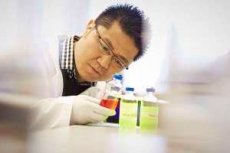New publications
Seawater - a new resource for energy production
Last reviewed: 02.07.2025

All iLive content is medically reviewed or fact checked to ensure as much factual accuracy as possible.
We have strict sourcing guidelines and only link to reputable media sites, academic research institutions and, whenever possible, medically peer reviewed studies. Note that the numbers in parentheses ([1], [2], etc.) are clickable links to these studies.
If you feel that any of our content is inaccurate, out-of-date, or otherwise questionable, please select it and press Ctrl + Enter.

One of Japan's leading universities has developed a new, efficient technology that makes it possible to obtain hydrogen peroxide suitable for use in fuel cells.
The new technology, developed by Japanese researchers, is the first method to use the acceleration of a chemical reaction by exposing the catalyst to sunlight, resulting in maximum efficiency and the possibility of using the resulting hydrogen peroxide in fuel cells.
The research project was led by Shunichi Fukuzumi and the scientists published the results of their research in a popular scientific journal.
Fuel cells currently run primarily on hydrogen gas, but the option proposed by Fukuzumi's team has a number of advantages, most notably that hydrogen peroxide is easier to store at high density. Today's technologies allow gaseous hydrogen to be stored using high pressure or low temperatures, and hydrogen peroxide is safer in this case, both during storage and transportation. The only problem was that scientists could not find effective photocatalytic methods for producing liquid hydrogen peroxide - there were technologies that did not use solar radiation, but the energy costs made them impractical.
But Fukuzumi's team has created another cell with a catalyst - a kind of solar battery that produces hydrogen peroxide. When sunlight is focused on the photocatalyst, an accelerated chemical reaction begins - seawater is oxidized and oxygen levels are reduced, resulting in the formation of hydrogen peroxide.
Fukuzumi's research team explained that the concentration of hydrogen peroxide in seawater after exposing the photocatalyst to sunlight for 24 hours was approximately 48 millimoles, an order of magnitude higher than previously reported (in pure water, the hydrogen peroxide level was approximately 2 millimoles).
Scientists were intrigued by this significant gap in the numbers, and they discovered that the problem was in the negatively charged chlorine present in seawater, which is responsible for increasing the reaction rate and contributing to an increase in the level of hydrogen peroxide in the water.
According to the researchers, the new technology for converting solar energy into electricity has an efficiency of about 0.3%, the efficiency of the photocatalytic method (using the acceleration of a chemical reaction) for producing hydrogen peroxide is 0.55%, and the efficiency of the fuel cell is 50%.
Of course, the overall efficiency of the new energy production technology is quite high, but conventional solar panels have proven to be more efficient today. Professor Shunichi Fukuzumi and his colleagues are confident that the efficiency of the new method can be improved by using improved materials for the photoelectrochemical cell, and the experts also plan to find ways to reduce the cost of energy production.

 [
[